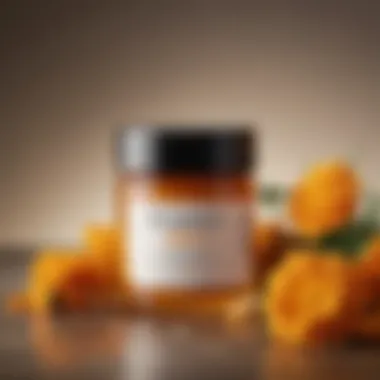Exploring Marigold Tincture: Benefits and Uses


Intro
Marigold tincture has established itself as a versatile elixir, prized not just for its vibrant hue but also for its myriad benefits. This golden liquid is derived from the cheerful marigold flower, known as Calendula officinalis. For centuries, cultures all over the world have harnessed its therapeutic properties in both traditional and modern practices.
In this exploration, we will uncover its preparation methods, therapeutic values, and multifaceted applications, especially in herbal medicine and skincare. By understanding the relevance of marigold tincture today, readers can make informed choices about integrating this herbal remedy into their lives. Whether you are an enthusiast delving into herbal remedies or a practitioner seeking new insights, this journey dives deep into what marigold tincture can offer.
Recipe Overview
Brief Summary of the Recipe
Marigold tincture is relatively simple to prepare and requires just a handful of ingredients, alongside a bit of patience while it marinates. This infusion extracts the beneficial properties of the marigold flowers through alcohol, ensuring a potent result that can be used in various applications.
Key Ingredients and Tools Needed
Here’s what you'll need:
- Fresh marigold flowers: Ideally harvested in full bloom for optimal potency.
- High-proof alcohol: Such as vodka or brandy, known for its ability to extract the essence of the herbs.
- Glass jar: For steeping your mixture, preferably with a tight-sealing lid.
- Strainer: To separate the liquid from the plant material after infusion.
- Dark glass dropper bottles: For storage and easy dispensing.
Step-by-Step Instructions
Detailed Cooking Steps
- Harvest and Prepare the Flowers: Begin by picking fresh marigold blooms, ensuring they are free from pesticides. Gently rinse them in cool water to remove any debris. Once clean, allow them to air dry on a clean towel.
- Fill the Jar: Loosely pack the flowers into the glass jar, filling it to about halfway.
- Add the Alcohol: Pour the high-proof alcohol over the flowers, ensuring they are completely submerged.
- Seal and Store: Tightly seal the jar and place it in a cool, dark location. Let it steep for at least two weeks, shaking it gently every few days to encourage the extraction process.
- Strain and Bottle: After the steeping period, strain the mixture using a fine mesh strainer or cheesecloth. Transfer the tincture into dark glass dropper bottles for storage.
Tips for Successful Execution
- Patience is Key: The longer the tincture sits, the stronger the flavor and health benefits. Some enthusiasts even let it steep for up to six weeks.
- Control Your Ratio: A common guideline is to use 1 part marigold to 2-3 parts alcohol, allowing flexibility based on personal preference.
- Label Your Bottles: Don’t forget to label your tinctures with the date and ingredients. This can save a lot of guesswork down the road.
Preparing marigold tincture allows you to embrace the wisdom of natural remedies while enjoying the rich heritage behind these practices. The tincture can be integrated into daily routines, offering not only health benefits but also bridging a connection to the age-old art of herbal medicine.
Prologue to Marigold Tincture
The world of herbal remedies is both vast and rich, with marigold tincture sitting comfortably among the botanical treasures that hold historical and modern-day significance. As we dive into this topic, it is crucial to recognize how marigold tincture has played a role not just in herbal medicine but also in skincare and culinary practices. Its bright petals and vibrant hue hint at the wellness benefits that lie within, waiting to be explored.
Definition and Composition
Marigold tincture is a concentrated liquid extract made from the petals and leaves of the marigold plant, often using Calendula officinalis, renowned for its golden blossoms. The preparation involves combining the plant material with a high-proof alcohol or glycerin, a process that extracts the active compounds of the plant. These compounds include flavonoids, carotenoids, and essential oils, all of which contribute to its therapeutic properties.
The composition is key, as it encapsulates the soul of the marigold in a bottle, allowing for a greater concentration of its benefits than would be found in the raw plant alone. When taken correctly, marigold tincture can deliver considerable advantages, alleviating various ailments while being easy to use.
Cultural Significance
Throughout history, marigold has been celebrated not only for its beauty but also for its medicinal attributes. Ancient cultures utilized Calendula in rituals and ceremonies, marking it as a symbolic flower for protection and healing. In folk medicine traditions, it was a common ingredient in remedies aimed at reducing inflammation and promoting skin health.
In many parts of the world, marigold is still used during festivities, where its bright colors adorn decorations, signaling renewal and vibrancy in seasonal changes. This cultural backdrop adds a layered dimension to marigold tincture, affirming that its use goes beyond mere utility; it embodies a connection to nature, health, and community.
Moreover, marigold tincture straddles the lines of traditional healing and contemporary wellness practices, making it relevant in today’s discussions about holistic health.
"The beauty of marigold tincture lies not only in its benefits but also in the rich tapestry of culture and history that surrounds it, reminding us of our connection to nature and the wisdom of past generations."
Understanding this importance is fundamental, as it sets the stage for exploring the many ways marigold tincture can be prepared and utilized, influencing various fields across health and beauty.
Historical Context
Understanding the historical context of marigold tincture offers insight into its evolution and significance in various cultures. Over the centuries, marigold has held a place of esteem among herbalists and traditional medicine practitioners. Not merely a garden ornament, marigold’s vibrant yellows and oranges have symbolized joy and prosperity, connecting those who use it to ancestral practices and folk remedies.


Traditional Uses
Marigold, particularly Calendula officinalis, has seen its fair share of applications throughout history. Ancient Egyptians revered the flower for its supposed powers to enhance beauty, while in Roman times, it was used in celebrations and religious rituals. Folk healers in various cultures have employed marigold for its healing properties, often using it to treat wounds and skin irritations. Its anti-inflammatory qualities made it a staple in remedies for eczema and sunburns. Traditional recipes have been handed down generations, illustrating a rich heritage of practical wisdom.
In rural settings, you might hear stories like how a grandmother would steep dried marigold petals in water to create an infusion. This concoction was utilized for everything from soothing sore throats to promoting digestive health. It’s a prime example of how plants, often seen as simple herbs, play deep roles in community health practices.
"In the hands of traditional healers, marigold was not just a remedy; it was a lifeline, intertwined with the fabric of life and culture."
Evolution of Tincture Preparation
Tinctures have a long history as well, tracing back to various adaptations of extracting plant essences. Originally, tinctures were made by steeping herbs in alcohol, a method that preserved the medicinal qualities of the plant. During the time of the Middle Ages, alchemists would meticulously craft tinctures, not only as remedies but also as explorations of chemistry and herbal knowledge. Marigold tincture, in particular, became a focus due to the flower’s plentiful availability and its diverse uses.
The preparation of tinctures has shifted over time; where once large wooden casks might have held the steeping herbs, modern practices now utilize glass jars for a more controlled infusion. This evolution reflects a growing understanding of botany and chemistry. Today, home herbalists often experiment with various techniques, learning from both ancient texts and contemporary research. The simplicity of marigold tincture preparation allows it to remain accessible, encouraging enthusiasts of all ages to delve into the world of herbal medicine, further bridging past traditions with current practices.
In essence, the historical journey of marigold tincture encapsulates a rich tapestry woven from cultural beliefs, medicinal practices, and community knowledge—its relevance continuing as we explore its benefits in modern health routines.
Preparation of Marigold Tincture
Preparing marigold tincture sets the stage for unlocking its myriad benefits. This process is not merely a task; it’s an art that brings the essence of the marigold flower into a potent liquid form. Getting this right is crucial, as the quality of the tincture depends heavily on the ingredients and methods used. With careful attention to detail, one can create a tincture that retains the therapeutic properties of marigolds while ensuring its safety for consumption and application.
Selecting the Right Marigold
Choosing the appropriate type of marigold is integral to the success of the tincture. Different varieties, such as the Calendula officinalis or the Tagetes species, boast unique properties. Calendula, in particular, is celebrated for its healing attributes, while Tagetes can offer antimicrobial benefits. When selecting marigolds, opt for organic blooms whenever possible, as they are less likely to contain harmful pesticides or chemicals.
Here are some key considerations:
- Color and Freshness: Look for bright, vibrant flowers, which indicate freshness and higher active compounds.
- Source: If feasible, grow your own marigolds to ensure they are free from toxins.
- Usage: Decide based on whether you need the tincture for topical use, ingestion, or both, as this will influence your choice of marigold variety.
Step-by-Step Tincture Making Process
Harvesting
Harvesting is the first step in this meticulous procedure, demanding both timing and technique. Ideally, marigolds should be picked early in the morning after the dew has evaporated but before the heat of the day kicks in. This timing helps capture the flowers' essential oils at their prime. An important characteristic of harvesting is that only fully opened flowers should be collected.
Why is this crucial? It’s because the potency of the tincture is heavily influenced by the timing of this process. Freshly cut flowers carry the highest levels of phytochemicals, which are pivotal for the tincture’s effectiveness. However, over-harvesting a single plant can stress it, leading to diminished yields in the long run, so practice sustainability.
Drying
Once you’ve harvested, proper drying is essential to enhance the marigold's properties while preventing spoilage. A slow drying process is suggested, as this preserves the delicate oils and compounds. The recommended method is hanging the flowers upside down in a dark, dry place with good air circulation.
By doing so, you maintain the marigold’s integrity and prevent mold growth. The dry flowers should feel crisp yet not crumble when touched. It's essential to avoid rapid drying techniques, like microwaving, as they can decrease the beneficial compounds in the flowers.
Infusing with Alcohol
The next step involves infusing the dried flowers with alcohol. This is where the magic happens. Use a high-proof alcohol, like vodka or brandy, as its high alcohol content extracts the desired constituents effectively. The ratio typically recommended is one part dried marigold to five parts alcohol. This process allows the active ingredients to leach out, creating a solution rich in healing properties.
Maintaining a dark place for the infusion is vital, as light can degrade the tincture over time. Shake the mixture daily for about four to six weeks. While this may seem tedious, it ensures the tincture is thoroughly infused and maximizes its potency.
Storage and Shelf Life
After the tincture has been adequately infused, proper storage becomes a necessity.Storing in tinted glass bottles is advisable, as it blocks out harmful light while maintaining the quality of the tincture. Ideally, a cool, dark cabinet is the best place for storage.
The shelf life can be impressive if done right, with tinctures potentially lasting for several years, thanks to the preservation qualities of alcohol. However, always keep an eye on color and smell; if the tincture develops an unusual odor or alters in color significantly, it’s best to discard it.
By following the steps outlined in this section, you'll be well on your way to crafting a marigold tincture that serves its purpose, whether it be for medicinal use, skincare, or just experimenting in the kitchen. The importance of each step should not be underestimated—it is through this preparation that the rich potential of the marigold flower is transformed into a beneficial tincture.
Therapeutic Properties


When discussing marigold tincture, it’s vital to highlight its therapeutic properties, which have garnered attention from those interested in herbal remedies and natural health. Marigold tincture, derived from the vibrant flowers of the Calendula genus, is rich in various compounds that offer numerous health benefits. This section explores its anti-inflammatory effects, antimicrobial activity, and notable skin health benefits, making it an intriguing topic for both practitioners and users seeking natural alternatives for healing and wellness.
Anti-inflammatory Effects
One of the standout characteristics of marigold tincture is its anti-inflammatory properties. Inflammation is a physiological response that can become problematic when it lingers too long, contributing to various ailments. Marigold’s active constituents, such as flavonoids and triterpenes, have been shown to inhibit specific pathways that lead to inflammation. By piping down the production of inflammatory mediators, marigold tincture can provide relief for conditions like arthritis, digestive disorders, or even general soreness.
It’s like having a soothing balm right from nature's garden; incorporating it can be a tremendous advantage for those seeking to combat inflammatory symptoms through herbal medicine.
Antimicrobial Activity
The antimicrobial activity of marigold tincture is yet another layer to its therapeutic prowess. Research indicates that compounds found in marigold exhibit effectiveness against a range of bacteria and fungi. This makes it suitable not only for internal use but also for topical applications. For instance, when applied on cuts or minor wounds, marigold tincture can help prevent infections, promoting faster healing. This ability to combat microorganisms is rooted in its natural antibacterial properties, which keep harmful agents at bay.
The increasing resistance of bacteria to conventional antibiotics has encouraged a broader look at alternatives like marigold tincture, which may offer a natural safeguard against infections.
Skin Health Benefits
Skin health is a complex affair, one that often requires multifaceted approaches. Marigold tincture emerges as a trusted ally due to its properties that foster better skin conditions.
Acne Treatment
Focusing on acne treatment, this tincture potentially reduces excess oil production, which can clog pores and lead to breakouts. Its anti-inflammatory and antimicrobial properties play a double role here, not only addressing the inflammation caused by acne but also tackling the bacteria that may lead to new flare-ups. Marigold tincture’s soothing quality can help calm angry skin, making it a popular option among natural skincare enthusiasts.
An interesting aspect is that while it offers pronounced benefits, the way marigold tincture impacts individual skin types will differ, a consideration that requires users to approach it with an open but cautious mindset.
Scar Healing
Another significant use involves scar healing. Applying marigold tincture can enhance the regeneration of the skin, helping to fade scars from injury or acne over time. Users often appreciate its ability to promote more even skin tone as it aids in cellular repair.
However, while marigold tincture has much to offer, results can vary. Some may find marked improvements, while others may need additional treatments. Therefore, it’s wise to set realistic expectations and perhaps consult a practitioner to understand the best course of action tailored to personal needs.
"Natural remedies like marigold tincture remind us that nature often has the answers to our modern ailments."
Ultimately, the therapeutic properties of marigold tincture are what make it a sought-after option in both herbal medicine and skincare. Its versatility illustrates why more and more individuals are turning to this age-old remedy in a world increasingly focused on natural healing.
Applications of Marigold Tincture
Marigold tincture isn’t just a pretty bottle sitting on a shelf; it serves a plethora of purposes that range from enhancing health to adding charm to everyday life. Its applications delve into herbal medicine, skincare, and even culinary arts, showcasing the versatility of this herbal extract. Understanding how marigold tincture can be incorporated into various aspects enriches its value, making it a worthwhile subject for study and practice.
In Herbal Medicine
Dosage Guidelines
When it comes to herbal remedies, dosage is king. The dosage guidelines for marigold tincture are particularly significant because they help bridge traditional wisdom and modern therapeutic application. Typically, a common recommendation is 1-2 ml of tincture taken two to three times a day. This amount offers a balanced approach, ensuring that potential therapeutic benefits don’t come with adverse effects.
Moreover, it’s important to note that individual responses can vary, emphasizing the need for personalized adjustments. People tend to gravitate towards these guidelines as they encompass a pragmatic blend of safety and effectiveness, making marigold tincture a favored choice for many.
On one hand, adhering to these guidelines can lead to positive results, but being cavalier with dosage can lead to unwanted side effects, especially for those with sensitivities. It’s always prudent to start on the lower end then gradually increase as needed.
Potential Interactions
Marigold tincture can interact with other herbal remedies and medications, making knowledge about potential interactions paramount. This is a double-edged sword; while the tincture offers therapeutic properties, it could heighten or diminish the effectiveness of certain drugs, so awareness here is crucial.
For instance, marigold may amplify the effects of blood-thinning medications. Such interactions underscore why the dialogue between users and healthcare providers is essential before starting any new treatment regimen.
Highlighting these interactions can lead to a better understanding of when marigold tincture is beneficial. Making informed decisions ensures users reap the positives while sidestepping potential pitfalls.


In Skin Care Products
Formulations
The beauty industry has taken a liking to marigold tincture, harnessing its restorative properties in a variety of formulations. The inclusion of this tincture in creams, lotions, and ointments showcases its anti-inflammatory and healing qualities, enhancing the overall efficacy of skincare products. It’s a standout ingredient for those looking to bring a natural touch to their skincare regime.
Notably, products combining marigold tincture with other active ingredients often resonate well with consumers. Its ability to calm skin irritations and promote healing makes it ideal for those battling acne or minor skin ailments. However, those with sensitivities should test products on a small patch of skin first. The unique aspect of formulations featuring marigold tincture is that they can often cater to sensitive skin types, widening its appeal.
Homemade Remedies
The appeal of homemade remedies has resurged in recent years, and marigold tincture shines here as well. Many individuals create their own creams or ointments featuring this tincture, harnessing its natural goodness without the unnecessary additives found in commercial products. This hands-on approach promotes not just self-reliance but also empowers users to take charge of their skincare.
Utilizing marigold tincture in homemade remedies enables flexibility in formulation, allowing for concentration adjustments according to personal skin needs. However, the downside is the lack of professional oversight; homemade products might not always achieve a stable formulation. Hence, while exciting and empowering, users should approach with care and maintain proper hygiene during the preparation process.
Culinary Uses
Marigold tincture isn’t confined to the realms of skincare and healing; it also makes its mark in culinary ventures. Used sparingly, it adds a sunflower-like flavor and bright yellow hue to dishes, enhancing not only the aesthetic appeal but also the nutritional value. Dishes like salads or sauces can gain an infused flavor with a few drops, showcasing marigold’s versatility.
Moreover, some use it in beverages for a herbal twist, further broadening its applicability. The uniqueness stems from its balance of earthiness and subtle sweetness, setting it apart from more conventional herbal additions. However, culinary use demands cautious experimentation; too much tincture might overpower the dish or lead to undesirable flavors.
In summary, the applications of marigold tincture range wide and deep, from herbal remedies to skin care and culinary experiments. Understanding its potential in these areas encourages a mindful and informed approach to its use, enabling individuals to explore the benefits while mitigating risks.
Safety Considerations
When diving into the world of marigold tincture, it’s crucial to keep an eye on safety considerations. While marigold offers an array of benefits, an understanding of potential risks can help ensure a positive experience. Safety encompasses a variety of aspects, including allergic reactions and contraindications that may arise from using this herbal remedy. Knowing these factors is key for anyone interested in incorporating marigold tincture into their routine, whether for health, beauty, or culinary purposes.
Potential Allergic Reactions
Marigold, or Calendula, is generally regarded as safe for most individuals. Yet, just because something is natural doesn't mean it's free from risks. Some people may find themselves allergic to marigold. Symptoms can range from mild to severe and may include:
- Skin rashes or itching
- Redness or swelling
- Respiratory issues if ingested or inhaled in large quantities
If you've had previous sensitivities to plants in the Asteraceae family—like daisies or ragweed—you might want to tread carefully. Conducting a patch test on a small area of skin before using the tincture widely is often a wise move. Around 24 hours of waiting can give you an idea if your skin will welcome marigold with open arms or if it might react unfavorably.
Contraindications
There are certain situations where marigold tincture might not be the best option. Individuals who are pregnant or breastfeeding should consult with a healthcare practitioner before using it, since its effects during these crucial times aren't well documented. Furthermore, those who are taking specific medications, such as anticoagulants, should also be cautious. This herb has the potential to interact with blood-thinning medications, thereby increasing bleeding risks.
In addition, people with conditions affecting the liver should be cautious as the alcohol used in the tincture may create additional strain on an already taxed organ.
"A stitch in time saves nine" - taking precautions can save a lot of complications down the road.
To sum up, while marigold tincture has an impressive range of uses and benefits, ensuring your safety should come first. Recognizing possible allergic reactions and knowing contraindications can make a world of difference in how one experiences this herbal remedy. It's always a good practice to consult a healthcare provider if there’s any doubt about its use, particularly for vulnerable groups.
Culmination
The exploration of marigold tincture leads to a remarkable accumulation of knowledge about its properties and uses. By understanding this topic, readers can better appreciate not just the herbal compound itself, but also the historical and cultural contexts that have shaped its use over the centuries.
Summary of Benefits
Marigold tincture boasts numerous benefits that range from therapeutic to culinary applications. It has gained a reputation primarily due to its potent anti-inflammatory and antimicrobial properties. Practitioners of herbal medicine often harness marigold tincture for its skin health benefits, particularly in treating acne and promoting scar healing. Additionally, its versatility extends to skincare formulations and even culinary delights, showcasing the herb's adaptability in various aspects of health and wellness.
Among the significant benefits are:
- Anti-inflammatory properties that help alleviate conditions like eczema and psoriasis.
- Antimicrobial effects that can contribute to improved skin conditions by combating acne-causing bacteria.
- Ease of preparation, allowing even novices to make their tincture at home with minimal effort.
"Exploring the uses of marigold tincture can open doors to natural remedies that have withstood the test of time."
Future Prospects in Research
Looking toward the future, research on marigold tincture offers exciting possibilities. As evidence continues to mount regarding herbal medicine and its role in holistic health, there is a growing need for scientific validation of traditional practices. Future studies may focus on:
- Investigating the specific compounds in marigold extract that contribute to its therapeutic effects.
- Assessing dosage variations and how different preparations affect efficacy.
- Exploring its uses alongside conventional medicine to gauge synergy in treatment protocols.







